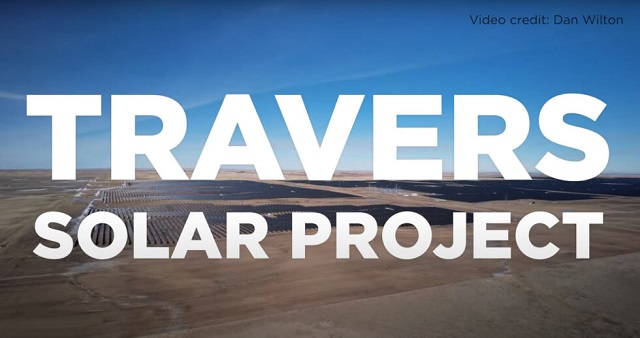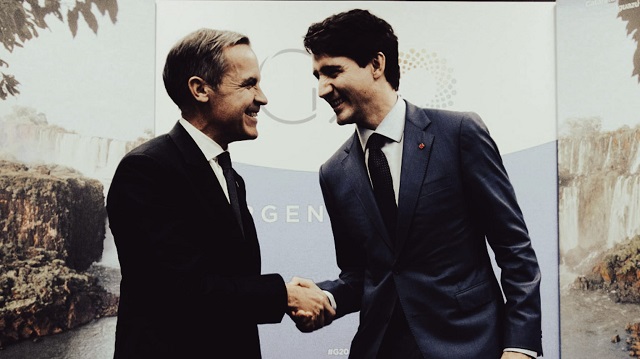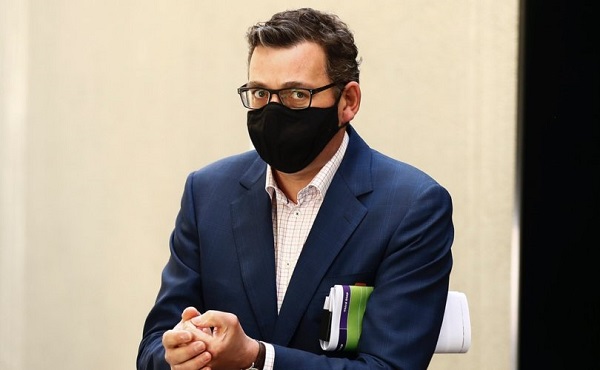Alberta
On Friday, Alberta’s energy minister hailed their largest solar project. On Sunday, it was producing 10.9% at noon

This was the opening splash for a video clip posted by the Alberta energy minister on social media. Two days later, its power output at noon was barely 11 per cent. YouTube/Canadian Energy Centre
From PipelineOnline.ca
Brian Zinchuk is editor and owner of Pipeline Online
And wind was doing even worse
Even though Alberta’s build-out of 38 wind farms and 36 solar farms have resulted in an enormous growth of nameplate power generating capacity, the reality was far from the advertised on Sunday, according to data from the Alberta Electric System Operator (AESO).
Despite the noon hour being defined as the sun being at its highest point in the sky, Alberta’s grid-scale solar facilities were having a tough day on Oct. 22. At 11:53 a.m., solar was producing 152 megawatts out of an installed base of 1,292 megawatts. That was 11.8 per cent of capacity. On a good day, that number is closer to 1,000 megawatts around noon.

Power generation in Alberta at 11:53 a.m. on Oct. 22. All numbers are in megawatts, MC is maximum capacity, and TNG is total net to grid. Alberta Electric System Operator
It wasn’t hard to figure out why solar hand tanked. A belt of heavy clouds, visible from Environment and Climate Change Canada satellite imagery, blanketed the principle solar power production region of southern Alberta.

Heavy clouds covered southern Alberta at 11:30 a.m. on Sunday. Environment and Climate Change Canada
Travers, the largest solar facility in Canada with a rated capacity of 465 megawatts and having cost $700 million, was producing 51 megawatts a few minutes before noon. That was 10.9 per cent. Ironically, Alberta Energy Minister Brian Jean had posted on LinkedIn on Oct. 20, “Did you know Alberta is home to Canada’s largest solar farm? Once we set clear rules around land use, reclamation and transmission, we’ll get back to work leading Canada and the world on renewable electricity. I’m proud of our energy workers. Check out this incredible clip 👇”
That 22 second video clip was originally posted by the Canadian Energy Centre, the Alberta government’s “war room,” whose mission is to set the record straight, as it were. “The Canadian Energy Centre’s mandate is to promote Canada as the supplier of choice for the world’s growing demand for responsibly produced energy,” says the Centre’s mandate.
Wind peters out
And wind power production was having an even worse day, with wind power plummeting as the morning turned into afternoon. By that time, wind was generating just 67 megawatts out of an installed based of 3,853 megawatts. That’s just 1.7 per cent of nameplate capacity.
So at that moment, combined wind and solar were producing 219 megawatts out of a nameplate capacity of 5,145, or 4.3 per cent of capacity.
Alberta’s final remaining coal-fired power facility was producing 802 of 820 megawatts of nameplate capacity, or 97.8 per cent. And its power output was 3.7 times the total output of all grid-scale wind and solar across Alberta, from 36 solar farms and 38 wind facilities, composed of hundreds of turbines and costing billions of dollars. As noted above, Travers, alone, cost $700 million and covers 3,330 acres with 1.3 million solar panels.
That last remaining coal plant, the Genesee Power Station, will soon be converted to natural gas, meaning an end to coal-fired power generation in Alberta – a province whose coal reserves run from Edmonton southwest to the BC and US borders.
The wind situation stayed much the same throughout the afternoon, and by 4:18, solar had dropped to 69 megawatts and wind was just 83 megawatts.

Wind generation in Alberta at 11:53 a.m. on Oct. 22. Twenty-four of 38 wind farms were producing exactly zero power at that moment. All numbers are in megawatts, MC is maximum capacity, and TNG is total net to grid. Alberta Electric System Operator
And near the supper hour, X bot account @ReliableAB noted AESO data showing wind was producing 86 megawatts and solar was producing 28 megawatts. At that moment, fossil fuels, principally natural gas, accounted 94.3 per cent of Alberta’s electricity. Alberta was getting 345 megawatts of power from imports, and batteries were contributing zero megawatts.
At this moment 94.3% of Alberta's electricity is being produced by fossil fuels. Wind is at 2.2% of capacity and producing 0.9% of total generation, while solar is at 2.2% of capacity and producing 0.29% of total generation. At the same time we are importing 345 MW or 3% pic.twitter.com/3gCrbqKvaI
— Reliable AB Energy (@ReliableAB) October 22, 2023
That 94.3 per cent is significant, because the federal government’s clean electricity regulations will require “unabated” fossil fuel power generation to shut down by 2035, with the exception that unabated natural gas generation could be used for up to 450 hours per year, per generator. As Premier Danielle Smith has pointed out, those hours would have been used up by the end of January in the calendar year of 2023, meaning by this time of year, Alberta’s grid, if those regulations were followed to the letter, would effectively be in almost total blackout. And to compound the situation, not only does the federal government expect provinces like Alberta and Saskatchewan to replace all that power generation in 11 years, two months and nine days, but also be on the path of increasing total power generation by a factor of 2.5x in 26 years, two months and nine days.
Brian Zinchuk is editor and owner of Pipeline Online
Alberta
Low oil prices could have big consequences for Alberta’s finances

From the Fraser Institute
By Tegan Hill
Amid the tariff war, the price of West Texas Intermediate oil—a common benchmark—recently dropped below US$60 per barrel. Given every $1 drop in oil prices is an estimated $750 million hit to provincial revenues, if oil prices remain low for long, there could be big implications for Alberta’s budget.
The Smith government already projects a $5.2 billion budget deficit in 2025/26 with continued deficits over the following two years. This year’s deficit is based on oil prices averaging US$68.00 per barrel. While the budget does include a $4 billion “contingency” for unforeseen events, given the economic and fiscal impact of Trump’s tariffs, it could quickly be eaten up.
Budget deficits come with costs for Albertans, who will already pay a projected $600 each in provincial government debt interest in 2025/26. That’s money that could have gone towards health care and education, or even tax relief.
Unfortunately, this is all part of the resource revenue rollercoaster that’s are all too familiar to Albertans.
Resource revenue (including oil and gas royalties) is inherently volatile. In the last 10 years alone, it has been as high as $25.2 billion in 2022/23 and as low as $2.8 billion in 2015/16. The provincial government typically enjoys budget surpluses—and increases government spending—when oil prices and resource revenue is relatively high, but is thrown into deficits when resource revenues inevitably fall.
Fortunately, the Smith government can mitigate this volatility.
The key is limiting the level of resource revenue included in the budget to a set stable amount. Any resource revenue above that stable amount is automatically saved in a rainy-day fund to be withdrawn to maintain that stable amount in the budget during years of relatively low resource revenue. The logic is simple: save during the good times so you can weather the storm during bad times.
Indeed, if the Smith government had created a rainy-day account in 2023, for example, it could have already built up a sizeable fund to help stabilize the budget when resource revenue declines. While the Smith government has deposited some money in the Heritage Fund in recent years, it has not created a dedicated rainy-day account or introduced a similar mechanism to help stabilize provincial finances.
Limiting the amount of resource revenue in the budget, particularly during times of relatively high resource revenue, also tempers demand for higher spending, which is only fiscally sustainable with permanently high resource revenues. In other words, if the government creates a rainy-day account, spending would become more closely align with stable ongoing levels of revenue.
And it’s not too late. To end the boom-bust cycle and finally help stabilize provincial finances, the Smith government should create a rainy-day account.
Alberta
Governments in Alberta should spur homebuilding amid population explosion

From the Fraser Institute
By Tegan Hill and Austin Thompson
In 2024, construction started on 47,827 housing units—the most since 48,336 units in 2007 when population growth was less than half of what it was in 2024.
Alberta has long been viewed as an oasis in Canada’s overheated housing market—a refuge for Canadians priced out of high-cost centres such as Vancouver and Toronto. But the oasis is starting to dry up. House prices and rents in the province have spiked by about one-third since the start of the pandemic. According to a recent Maru poll, more than 70 per cent of Calgarians and Edmontonians doubt they will ever be able to afford a home in their city. Which raises the question: how much longer can this go on?
Alberta’s housing affordability problem reflects a simple reality—not enough homes have been built to accommodate the province’s growing population. The result? More Albertans competing for the same homes and rental units, pushing prices higher.
Population growth has always been volatile in Alberta, but the recent surge, fuelled by record levels of immigration, is unprecedented. Alberta has set new population growth records every year since 2022, culminating in the largest-ever increase of 186,704 new residents in 2024—nearly 70 per cent more than the largest pre-pandemic increase in 2013.
Homebuilding has increased, but not enough to keep pace with the rise in population. In 2024, construction started on 47,827 housing units—the most since 48,336 units in 2007 when population growth was less than half of what it was in 2024.
Moreover, from 1972 to 2019, Alberta added 2.1 new residents (on average) for every housing unit started compared to 3.9 new residents for every housing unit started in 2024. Put differently, today nearly twice as many new residents are potentially competing for each new home compared to historical norms.
While Alberta attracts more Canadians from other provinces than any other province, federal immigration and residency policies drive Alberta’s population growth. So while the provincial government has little control over its population growth, provincial and municipal governments can affect the pace of homebuilding.
For example, recent provincial amendments to the city charters in Calgary and Edmonton have helped standardize building codes, which should minimize cost and complexity for builders who operate across different jurisdictions. Municipal zoning reforms in Calgary, Edmonton and Red Deer have made it easier to build higher-density housing, and Lethbridge and Medicine Hat may soon follow suit. These changes should make it easier and faster to build homes, helping Alberta maintain some of the least restrictive building rules and quickest approval timelines in Canada.
There is, however, room for improvement. Policymakers at both the provincial and municipal level should streamline rules for building, reduce regulatory uncertainty and development costs, and shorten timelines for permit approvals. Calgary, for instance, imposes fees on developers to fund a wide array of public infrastructure—including roads, sewers, libraries, even buses—while Edmonton currently only imposes fees to fund the construction of new firehalls.
It’s difficult to say how long Alberta’s housing affordability woes will endure, but the situation is unlikely to improve unless homebuilding increases, spurred by government policies that facilitate more development.
-

 2025 Federal Election2 days ago
2025 Federal Election2 days agoMark Carney: Our Number-One Alberta Separatist
-

 2025 Federal Election2 days ago
2025 Federal Election2 days agoNine Dead After SUV Plows Into Vancouver Festival Crowd, Raising Election-Eve Concerns Over Public Safety
-

 International2 days ago
International2 days agoJeffrey Epstein accuser Virginia Giuffre reportedly dies by suicide
-

 2025 Federal Election2 days ago
2025 Federal Election2 days agoColumnist warns Carney Liberals will consider a home equity tax on primary residences
-

 2025 Federal Election1 day ago
2025 Federal Election1 day agoCanada is squandering the greatest oil opportunity on Earth
-

 International1 day ago
International1 day agoU.S. Army names new long-range hypersonic weapon ‘Dark Eagle’
-

 COVID-1920 hours ago
COVID-1920 hours agoFormer Australian state premier accused of lying about justification for COVID lockdowns
-

 Addictions20 hours ago
Addictions20 hours agoFour new studies show link between heavy cannabis use, serious health risks



